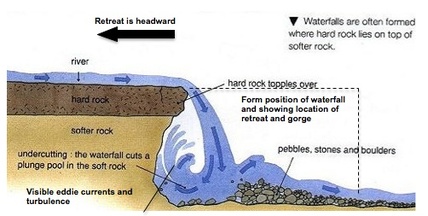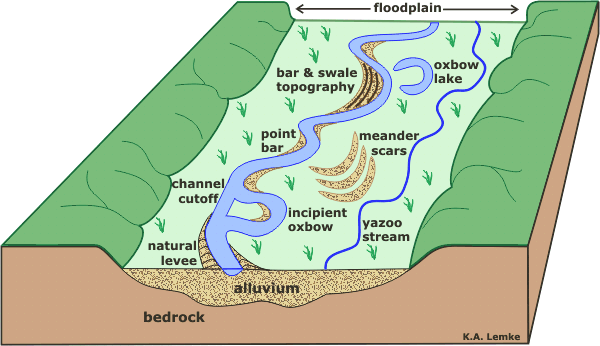TOPIC: |RIVER SYSTEM
Sub topic: River profile
What is a long profile?
The long profile shows how a river’s
gradient changes as it flow from its source to its mouth. A river changes shape
as it flows from its source (where a river starts) to its mouth (where a river
flows into a sea or lake). The shape of both the long profile (a slice through
the river from source to mouth) and the cross profile (a slice across the
river) changes.

The youthful or upper course of a river
The upper part is steep and the river
cuts a narrow and deep V-shaped channel. Further towards the sea, the slope is
gentler and the river has a wider channel. In the youthful stage, a river is
full of vigor and splash it forms interlocking spurs, Plunge pools, V-shaped
valleys, Gorge, River canyon, water fall, rapids and potholes.

The
mature stage of a river
In the mature stage, a river slows the
speed of flowing and it forms the U-shaped valley, Bluffs, Cliffs. The middle
course of a river has more energy and volume then in the upper course. The
gradient is gentler and lateral (sideways) erosion has widened the channel. The
river channel has also become deeper. Meanders are typical landforms found in
this stage of the river


The lower course of a river
Nearly all rivers have an upper,
middle, and lower course. The beginning of a river, when it flows
quickly with lots of energy, is called a young river. The river
here is smaller and usually has a rapid, tumbling flow that cuts a narrow
channel through rocky hills or mountains. In the old stage, a river is too slow
in flowing and it forms the Flood plain, braided channel, meanders, ox-bow
lakes, meander scars, Distributaries, Differed tributaries, Lagoons and Deltas.
River profile summery
| Upper Course | Mid Course | Lower Course | |
| Long Profile | Steeply sloping towards the lower sections of the river. | Shallow slopes towards the mouth of the river. | Almost at sea level, very gently sloping towards its mouth. |
| Cross Profile | Steep sided v-shaped valley. Thin river channel, deep in places. | V-shaped valley remains with a wider valley floor and the river begins to meander across it. The river channel begins to widen and become deeper. | Wide, shallow valley, with large flood plains and meanders. The river channel is wide, deep and smooth sided. |
- What is a long profile?
- Outline the stages of the river profile.
- Outline three features formed in each stage.

